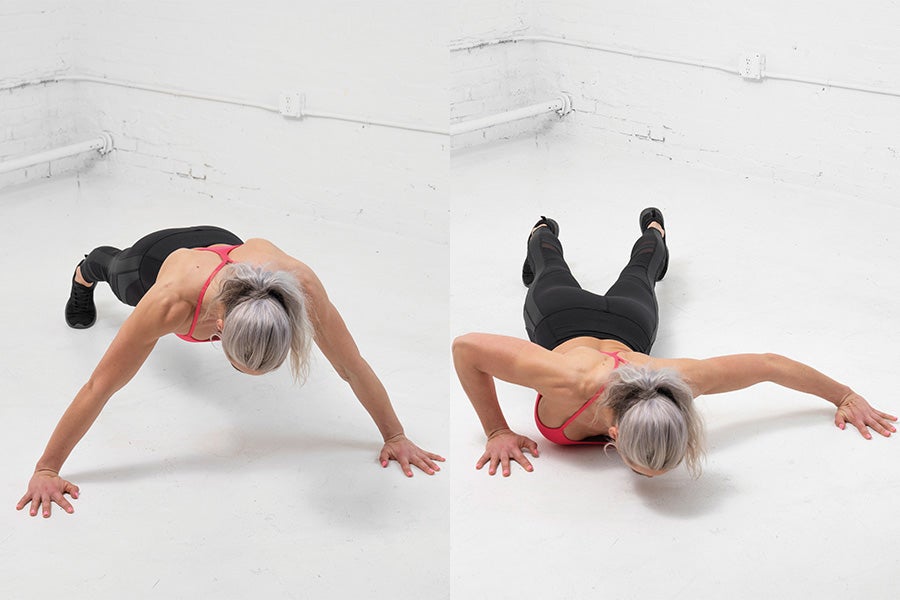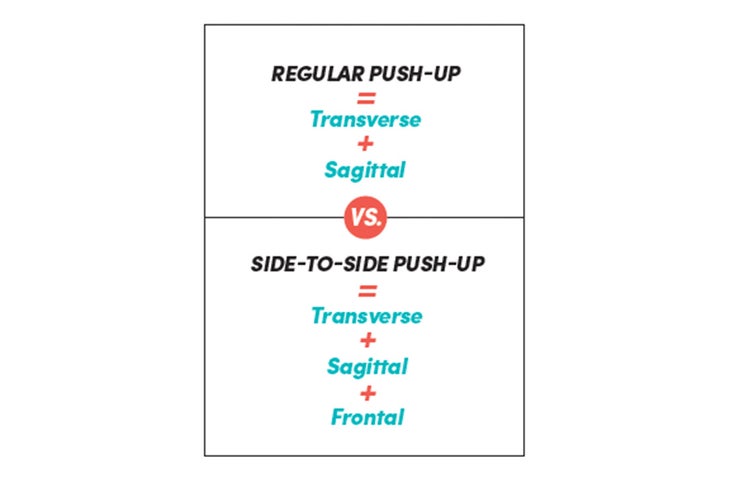
8 Exercises to Get You Moving in the 3 Planes of Motion
Get access to everything we publish when you
sign up for Outside+.
There seems to be a disconnect between real life and exercise. “We do not live in a one-dimensional world,” says Samantha Parker, MS, CPT, 500-hour RYT, author of Yoga for Chronic Pain … WTF? (Neoteric Movement Systems, June 2018). “We’re constantly twisting and turning, whether it’s to pick up children, put luggage in an overhead bin or move through a crowd of people.”
Indeed, our bodies are constantly moving in multiple directions — otherwise known as the three “planes” of motion — and can flip between them effortlessly. However, when it comes to exercise, movement patterns have strayed far from the natural, and people tend to execute 10 tidy reps of an exercise squarely in one single plane — for example, biceps curls, squats, crunches or lateral raises — which doesn’t really prep you for tennis or housecleaning or the zombie apocalypse.
To be ready for anything life — and exercise — throws your way, expand your workout dimensions with these eight exercises. A simple change in angle, direction or focus can instantly alter your plane of movement and create an entirely new and challenging exercise. Add them to your routine and see how these plane changers can be game changers!
The Plane Truth
Use a sheet of paper to help you envision the three planes of motion as they relate to the human body.
Sagittal Plane
Hold the paper in front of your nose so it splits your body vertically into two halves. Now imagine that the vertical paper represents a track along which all sagittal exercises must occur. Moves that involve flexion and extension (forward/backward) fall into this plane, such as back extensions, biceps curls, squats and running.
Frontal (Coronal) Plane
Imagine that your body is pressed between two plates of glass and that the paper held above your head splits you into front and back halves. Side-to-side movements and lateral exercises occur in the space between the glass, such as side bends, jumping jacks and leg abduction/adduction.
Transverse (Horizontal) Plane
Hold the paper horizontally in front of your bellybutton so it bisects you into top and bottom halves. All rotational movements in which your halves move in opposition occur in this plane, such as cable woodchoppers and bicycle crunches. Rotational movement of an individual limb is also considered transverse, such as internal or external rotation of your leg or arm. And if the limb is held at 90 degrees to your body and moves toward or away from your centerline, such as with a bench press or the inner/outer thigh machine, it is also classified as transverse.
Exercises to Get You Moving in Different Planes
Side-to-Side Push-Up

A standard push-up occurs in both the transverse and sagittal planes, but adding the side-to-side element also incorporates the frontal plane and kicks up the need for core stability. “Moving side to side also recruits the serratus anterior a little better than a traditional push-up, where the larger pectoral muscles dominate,” says Jennie Gall, a Pilates studio owner in Ripon, California.
Get into a push-up position with your hands on the floor outside your shoulders, your legs extended behind you, and your head, hips and heels aligned. Shift your body toward the right side, and then bend your elbows to lower your chest down as close as you can to your right hand. Extend your elbows and return to the center. Continue, alternating sides.

Remember, if your body changes position — e.g., lying down versus standing up — the movement plane changes with you. For example, a push-up (facedown), a seated machine chest press (facing forward) and a bench press (faceup) all occur in the transverse plane.
Alternating Knee-to-Elbow

“Typically, people bend at the waist, as with a crunch, to touch their elbow to their knee,” Parker says. “Here, stay tall and bring the knee up to meet the elbow to keep your lats, obliques and core-stabilizing muscles lengthened.” In other words, because you are more upright, the twisting motion becomes transverse.
Stand with your feet shoulder-width apart and place your hands behind your head with your elbows flared out. While remaining fully upright, twist to the left as you raise your left knee as high as you can in front of you. Pause and hold a few counts, then return to center. Continue, alternating sides.
Your rotational capacity may be limited because of mobility issues, so with each rep, try to twist a little farther with your upper body.

Curtsy Lunge

Forward lunges happen in the sagittal plane and work all the major muscles of the lower leg. Adding a curtsy changes the plane and adds a few more muscles to the mix. “A curtsy lunge really targets the gluteus medius and the inner and outer thighs,” says Patricia Friberg, West Coast barre ambassador at Equinox and creator of the Bottom Line & a Core Defined and Belly Beautiful workout DVDs. “Adding the curtsy can also improve pelvic stability and body alignment and reduce the potential for low-back pain.”
Stand with your feet shoulder-width apart, hands on your hips. Keep your torso erect as you step your right foot across and behind your left, bending both knees to lower into a lunge while keeping your hips square. When your left knee makes a 90-degree angle and your right knee nearly touches the floor, push off your right foot and drive down into your left heel to return to the start. Continue, alternating sides.

Side-Twisting Plank + Pike


The plank is a pretty standard exercise to train core stability, endurance and strength. You can, however, level up your ho-hum plank by adding a little movement in the transverse plane, says Leslee Bender, ACSM, NASM, creator of the Bender Ball. The pike challenges your rectus abdominis and core muscles, and the twist into a side plank engages the obliques and trains proprioception and balance, Bender says.
Get into plank with your hands underneath your shoulders and your head, hips and heels aligned. Lift your hips upward and press back as if going into Downward-Facing Dog. Hold briefly, then return to plank. Now lift your right hand off the floor and reach it for the ceiling, opening your body to the right in a side plank. Hold briefly, then return to plank. Continue, alternating sides.

Medicine-Ball Side Slam


A traditional medicine-ball slam works your entire front body (and gets out your frustrations) as you use whip-like forward flexion to slam the ball into the ground. But shifting the impact zone to the side changes your core engagement and plane of motion. “Both slams begin by engaging the lats and finish through the triceps and core,” explains Jason Kozma, PROPTA-CPT, owner of High Performance Personal Training in Los Angeles. “But this variation shifts the emphasis to the obliques.”
Stand tall and hold a medicine ball in front of you with both hands. Quickly lift it overhead and, keeping your hips and feet pointing forward, use mostly your upper body and obliques to forcefully throw the ball to the floor, releasing it about knee level so it strikes the ground outside your right foot. Pick the ball up and continue, alternating sides.

One-Arm Kettlebell Lawn-Mower Pull

A standard barbell row engages the major muscles of the back and requires solid stabilization from the core. “A lawn-mower row also gives you the opportunity to increase the stretch at the start and to finish with a greater contraction because your range of motion is not limited by the barbell coming in contact with your abdominals,” Kozma says. The rotational element changes this from a sagittal plane movement to a transverse one, engaging additional muscles in the core such as the obliques and the serratus.
Hold a kettlebell with your right hand and assume a staggered stance with your right leg back. Hinge forward from your hips, back flat, and lightly place your left hand on your thigh for balance. Extend your right arm straight down with your palm facing inward. Then drive your elbow up and back, and as the kettlebell comes close to your flank, open your upper body to the side and drive your elbow up and back until you reach the top of the motion. Pause briefly, then return to the start. Complete all reps on one side before switching.
For a greater range of motion, perform an exaggerated stretch at the bottom of each rep, twisting and reaching the weight toward the floor as if actually grasping and then pulling the starter cord on a lawn mower.


Lateral Step-Up and Over
Step-ups are an obvious sagittal plane movement, right? Not always. “A lateral step-up, where you’re sideways to the box or platform, changes the exercise to the frontal plane,” says Samantha Clayton, ISSA-CPT, vice president of Worldwide Sports Performance and Fitness for Herbalife Nutrition and former Olympic track athlete for Great Britain. “The same muscles are activated in both versions, but the lateral movement requires a little more coordination and balance, and gives the adductor and abductor muscles a little more stimulation.”
Stand sideways to a plyo box or platform with your left side closest, hands at your sides or on your hips. Place your left foot completely on top of the box, then extend your left leg and come to standing on top with both feet. Step off the opposite side with your left foot, then follow with your right. Go back the way you came, leading with your right foot and following with your left.
Start with a low 12-inch step to learn the movement pattern before attempting a higher one.
Carioca Run

A carioca doesn’t beat straight-ahead, sagittal-plane running when it comes to cardiovascular efficacy, but it has other practical and performance-based benefits, not the least of which is rotational strength and endurance. “Carioca is also a great drill for athletes who have to change directions quickly in their sport,” Clayton says. “And the lateral motion engages the abductors, which aren’t used much in forward running.”
Find a wide-open area and hold your arms in an athletic-ready position in front of you. Start by going to the right: Step to the side with your right foot, then step across and behind with your left foot. Step out again with your right foot, then step across and in front with your left foot. Your hips should fully rotate in both directions, and your arms should twist in opposition to your hips. Repeat this pattern slowly and speed up as you get comfortable, going for distance or time. To go to the left, face the same direction and reverse the foot pattern so you’re leading with your left foot and stepping behind/in front with your right.

Published at Thu, 24 Mar 2022 04:17:47 -0700






